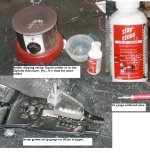Mickey
Lifetime Supporting Member
The narrow slot makes for a much neater job (IMO), especially when connecting wires to a horizontal terminal strip on a brick-style PLC.
BRICK-STYLE PLC, whats that?
The narrow slot makes for a much neater job (IMO), especially when connecting wires to a horizontal terminal strip on a brick-style PLC.
elevmike said:I dont think is proper to say "always use ferrules". It depends on the terminl, wire type, etc..and how carfull your panel builder is. I've seen many cases where the wire has broken off at the ferrule in some applications due to vibration.
In most cases where a ferrule might otherwise be used, we typically solder dip the wire. Basicly we have a small pot of liquid flux and American Beauty solder pot. This takes much less time and seems to be far more effective.
Johnny T said:Putting on ferrules doesn't take that long if you have the right tool. I've got a tool that takes a strip of ferrules and its a wire cutter / stripper / crimper all in one. The ferrules come in strips of about 30? or so and they load into the tool. Its very quick for putting on ferrules and can do any size up to 4mm (green ones?) I think.

There shouldn't be a problem with ferrules coming off the wire as long as they are put on properly ie. the tool is calibrated correctly and the person operating it uses the right part of the die for that ferrule...

Johnny T said:Putting on ferrules doesn't take that long if you have the right tool. I've got a tool that takes a strip of ferrules and its a wire cutter / stripper / crimper all in one. The ferrules come in strips of about 30? or so and they load into the tool. Its very quick for putting on ferrules and can do any size up to 4mm (green ones?) I think.
I put a florescent light in every panel. Nice to open the door and there is light. I would rather have conduit that is a narrow width but rather deep. This keeps the foot print smaller. I try to keep 40% empty room in the conduit. My job specs usually call out whether the cabinet is to be NEMA 12, 4 or 4X. But I usually pick the size. I'm not authorized to throw money around on a cabinet that is oversized. I allow for 20% future expansion which is a typical spec. If mounting a door-mounted OIT, I put the centerline no higher than 60" from the floor.
